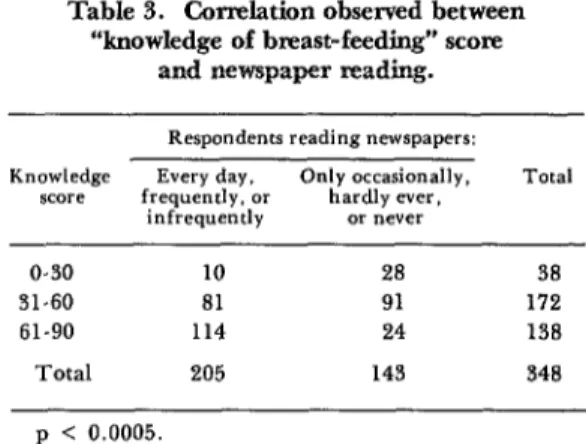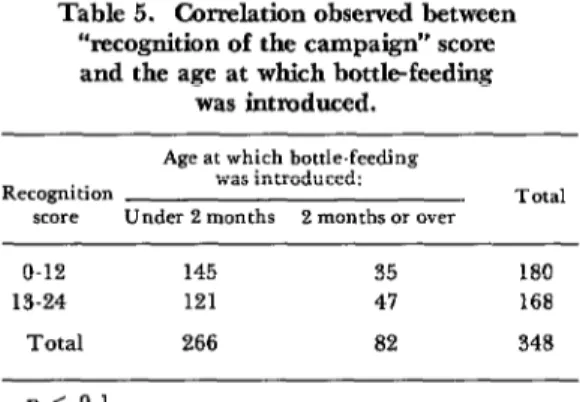Bull Pan Am Health Organ 12(2), 1978.
EVALUATION OF A BREAST-FEEDING CAMPAIGN IN TRINIDAD
Miguel Gueri? Peter Jutsum,’ and Alison White4
There has been a marked decline in breast-feeding throughout the developing world. It is generally agreed that this trend should be reversed, and that in achieving this objective mass communication media could play an important role. The present article analyzes the results of a campaign to promote
breast-feeding in which the press, television, and radio were used. It is hoped that this analysis will prove useful for other individuals and groups that may wish to plan similar campaigns.
In 1974 the Housewives’ Association of Trinidad and Tobago launched a campaign to promote breast-feeding. The campaign lasted six weeks. During that time five dif- ferent posters were published in the daily newspapers (18 issues) and shown on television (once a day), and six different radio advertisements lasting 15 to 20 seconds each were broadcast by two local radio stations an average of four times a day. The advertisements and posters were designed by professional advertisers.
Although nutrition education using the mass media has been carried out in the Caribbean for quite some time, it has usually taken the form of rather lengthy radio talks or newspaper articles. This breast-feeding campaign, which was orga- nized entirely by a group of private citizens, differed in that it used the same techniques employed by business firms to promote the sale of their products.
The Caribbean Food and Nutrition In- stitute (together with the Nutrition Unit of the Ministry of Health) had been involved
‘Also appearing in Spanish in the Boleth de la Oficina Sanitaria Panamericana.
ZMedical Nutritionist, Caribbean Food and tiutri- tion Institute, U.W.I. Campus, St. Augustine, Trini- dad, W.I.
SSystem Analyst, Caribbean Food and Nutrition Institute, Mona Campus, Kingston 7, Jamaica, W.I.
aVice-President, Housewives’ Association of Trini- dad and Tobago (HATT), IH Santa Anna Gdns., Tunapuna, Trinidad, W.I.
in giving some advice on nutrition during the planning and preparation of the adver- tisements, and it was felt the institute should assess the success of the campaign in terms of the proportion of the target population reached, the campaign’s in- fluence in improving the target popula- tion’s knowledge about breast-feeding, and the campaign’s effectiveness in reducing the early introduction of bottle-feeding.
Methodology
The sample consisted of women deliver- ing babies at the two largest public hospitals (Port-of-Spain General Hospital in northwest Trinidad and San Fernando General Hospital in southwest Trinidad) during a period of six weeks immediately following the end of the campaign. Women with abnormal deliveries requiring surgi- cal intervention and administration of a general anesthetic, those delivering twins or babies weighing 2,500 grams or less, and those living more than approximately 20 miles from the hospital were excluded from the study.
The mothers selected for the study were interviewed on two separate occasions. The first interview was conducted while they were still at the hospital, within 48 hours after delivery. The interviewers were two registered nurses who had recently worked
Gueri et al. l BREAST-FEEDING CAMPAIGN IN TRINIDAD 113
at the respective hospitals where they were conducting the interviews, and who had been trained for this exercise by one of the authors.
During this in-hospital interview, gener- al information about the respondents and their partners was collected. This included information concerning their knowledge about breast-feeding and human milk (particularly those points stressed during the campaign) and their plans for feeding their newborns. Some of the questions asked were designed to assess exposure to mass media, but the campaign was not mentioned at any time, nor was any attempt whatever made to influence the subjects’ views on breast-feeding or their plans for feeding their newborns.
The second interview was conducted four months later, at each respondent’s home, to determine the actual feeding practices employed. At this time direct questions regarding the campaign were asked. The campaign posters were shown, and the respondents were asked whether they had seen them before, whether they had read them, and if so whether they agreed with what was written. The tapes with the audio advertisements were played, and again the mothers were asked whether they recognized these messages and whether they agreed with them.
To assess each woman’s knowledge of breast-feeding a “knowledge” scoring sys- tem was devised. The score achieved was based on the answers the woman gave to questions related to breast-feeding that were asked during the first interview. The maximum possible score was 90.
In addition, to assess the overall impact
of the campaign on each woman, a
“recognition” scoring system was devised. Here the score achieved depended on whether the woman had seen and read (or heard) the various campaign messages, and if so whether or not she agreed with them. In this case the maximum possible score was 25.
Sample Characteristics
A total of 418 women were interviewed at the hospitals, and 348 were reinterviewed four months later at home. (Sixty-three of the 70 mothers remaining could not be located, and in 7 cases the child had died.)
Most of the women (97.4%) had five or more years of primary education, and a good proportion (28.9’%) had some second- ary education. Only 94 of thegroup (22.50J0) were working, but 87 more (21%) were planning to return to work. Racially, East Indians and Negroes were almost equally represented. More than half the women (56.9yo) were married, while one-quarter (25.1%) maintained stable common-law unions. Most of the male partners were skilled or semiskilled workers (34%) or unskilled laborers with fairly regular jobs (24.6%). Only a few of the male partners (6yo) were unemployed, the remaining 35.4% being white-collar workers (clerks, salesmen, supervisors, and the like).
Partly because over half the deliveries in Trinidad take place at the Port-of-Spain and San Fernando General Hospitals, the women in this sample were fairly repre- sentative of low and lower-middle income groups living in urban and semi-rural areas.
Results
114 PAHO BULLETIN -__ l vol. XII, no. 2, I978
Table 1. Correlation observed between Table 3. Correlation observed between “knowledge of breast-feeding” score “knowledge of breast-feeding” score
and radio listening. and newspaper reading.
Respondents listening to the radio: Knowledge Frequently Only occasionally,
score or hardly ever, infrequently or never
O-30 18 20
31-60 106 66
61-90 118 20
Total 242 106
p < 0.0005.
Total
38 172 138 348
Respondents reading newspapers: Knowledge Every day, Only occasionally,
score frequently, or hardly ever, infrequently or never
O-30 10 28
31-60 81 91
61-90 114 24
Total 205 143
p < 0.0005.
T0td
38 172 138 348
anything but the catch phrase (“Every baby deserves the breast”) which was printed in large type. Almost all the respondents who had heard or read the ads said that they agreed with the messages conveyed.
When the advertisements were considered one by one, no significant relationship was found between the age at which bottle- feeding began and the mother’s recognition of the ad, However, when the recognition score was applied, an inverse correlation, significant at the 10% level, was found between high scores and introduction of bottle-feeding before the age of two months (Table 5).
Discussion
The Breast-Feeding Campaign in Trini- dad was organized by a group of concerned
Table 2. Correlation observed between “knowledge of breast-feeding” SCOIX
and television viewing.
housewives with the technical assistance of health staff workers. This combination of forces is, in the opinion of some experts, the one that can most effectively promote breast-feeding (I). Berg (2), discussing the decline in breast-feeding, has said: “The same advertising techniques that partly are responsible for the increase in artificial feeding can be used to counter the trend.” To our knowledge, however, the Trinidad Campaign represented the first time that this type of approach was used in the Caribbean. We found, furthermore, that it was quite successful in reaching a large percentage of the target population, the radio alone being much more effective than the press and television combined.
It can be argued that the highly signifi- cant correlation between knowledge of breast-feeding and exposure to mass media is not one of cause and effect. That is, the more- educated women would be more
Respondents watching television: Knowledge Frequently Only occasionally,
score or hardly ever. infrequently or never
O-30 6 32
31-60 46 126
61-90 72 66
Total 124 224
p < 0.0005.
Total
38 172 138 348
Table 4. Correlation observed between “knowledge of breast-feeding” score
and attendance at prenatal clinics.
Knowledge Frequency of clinic attendance
Less than 5 times 5 or more times Total score
O-90 13 22 35
31.60 39 115 154
61.90 25 100 125
Total 77 237 314
Gueri et al. l BREAST-FEEDING CAMPAIGN IN TRINIDAD 11.5
Table 5. Correlation observed between “recognition of the campaign” score and the age at which bottlefeeding
was introduced. Age at which bottle-feeding
Recognition was introduced: Total score Under 2 months 2 months or over
o-12 145 35 180
13-24 121 47 168
Total 266 a2 348
p < 0.1.
likely to know about the value of human milk and the importance of breast-feeding, and they would also be more likely to read newspapers frequently and more likely to find a television set within their means. In other words, they would know about the subject before being exposed to the cam- paign through the mass media. This is indeed quite possible. However, we have to
keep in mind that the sample group was fairly homogeneous from a socioeconomic as well as an educational point of view; that the questions on which the knowledge score was based were the points stressed during the campaign; and, finally, that the radio is probably heard much more fre- quently by people in relatively low socio- economic groups. For all of these reasons, we are inclined to think that higher knowledge scores were the result of the campaign.
Analysis of the recognition score and its relationship to the age at which artificial feeding was introduced would suggest that the cumulative effect of the campaign may have dissuaded some mothers from intro- ducing their babies to the bottle at an early age. These results therefore suggest that in planning future breast-feeding campaigns, preference should be given to broadcasting short radio advertisements that are to the point and frequently repeated.
A campaign to promote breast-feeding was organized in 1974 by a Housewives’ Association onTrinidad. This article provides an assessment
of that campaign, based on interviews with mothers delivering babies at Trinidad’s two largest public hospitals just after the end of the campaign.
Analysis of these interviews indicates that the campaign reached a large proportion of the
target population. A close relationship was observed between the respondents’ exposure to mass media and their knowledge concerning breast-feeding and the value of human milk. There was also a positive correlation, significant at the 10% level, between avoidance of bottle feeding before infants were two months old and maternal familiarity with the campaign’s media messages.
REFERENCES
(I) Jelliffe, D. B., and E.F.P. Jelliffe. (Ed.). (2) Berg, A. The Nutrition Factor. The “An Overview.” In: The uniqueness of human Brookings Institution, Washington, D.C., 1973. milk. Symposium published in AmJ Clin Nutr

